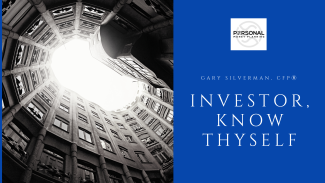
Don’t Lock in Your Losses
Last week we looked at an example of someone who got out of the market before a huge crash that never happened. The end lessons we got from that:
1) If you predict a market catastrophe and it doesn’t occur, you are giving up some serious money by missing on the gains.
2) Market catastrophes do hurt and that hurt can last many years before you get back to where you were.
3) Rebalancing does help control risk.
Today we'll look at the same basic scenario, with a few changes. After a prolonged up market, the investor decided to get out of cash and get back in the market. The conversation went something like this: “We got scared, jumped ship, and missed a great market. We understand the error of our ways and are ready to get back in.”
You’d think I like to hear things like that. Well, no. They feared a market correction and got out. The market kept going up. The longer and higher a market goes up, the closer it is to the next correction. They demonstrated that they are fearful of corrections but now they wanted in again. Bad things can happen with this combination.
Still, they convinced me that they knew all of this and would stay the course when the next correction, crash, or bear market occurred. They said they were ready to ride the ups and downs of the market to get the favorable long-term returns it could provide.
Then the correction hit. They lasted a couple months and pulled out their money.
That was not good for them.
The lessons for this scenario:
- If you predict a market catastrophe and it doesn’t occur, you are giving up some serious money by missing on the gains.
- Market catastrophes do hurt and that hurt can last many years before you get back to where you were.
- Selling after the market goes down locks in your losses and leaves you out of position to recover to where you were.
Between last week’s and this week’s scenario, if I had to choose the “best” wrong thing to do, I’d go with last week. Missing out on gains is a lot better than locking in losses. No matter what you can talk yourself into, if you are nervous and want to jump ship every time the market twitches—don’t go into the stock market.
If you only get nervous if the loss is 10% or 20%, then only use stocks to a level that if a worst-case scenario happens you will not go past what you can stand. This is the whole idea behind why we try to measure a client’s risk tolerance before investing any of their money.
You might say (usually while the market is up) that you can stand a big drop, no problem. But the reality could be different. Best to figure it out ahead of time.
Gary Silverman, CFP Ⓡ, is the founder of Personal Money Planning, a Wichita Falls retirement planning and financial planning firm and author of Real World Investing.

